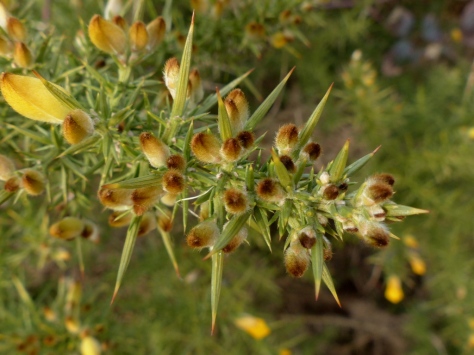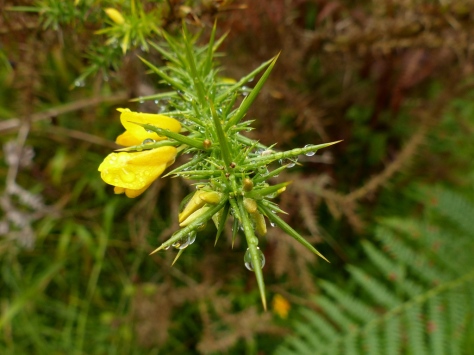 Also known as Furze or Whin, Common Gorse is a spiky shrub of the Pea family, It bears bright yellow flowers.
Also known as Furze or Whin, Common Gorse is a spiky shrub of the Pea family, It bears bright yellow flowers.



 The structure of a Pea flower:
The structure of a Pea flower:
Like other members of the Pea Family the calyx of Ulex europaeus is made up of five sepals but these are fused together.
 When the calyx opens it splits into two halves, a top lip and a bottom lip, giving the appearance of just two sepals.
When the calyx opens it splits into two halves, a top lip and a bottom lip, giving the appearance of just two sepals.
 The flower has five yellow petals and the petals have names.
The flower has five yellow petals and the petals have names.
 The top petal is called the “Banner” or “Standard” petal. The two petals that form a boat like shape, bottom, centre are called the “Keel” petals and these house the stamens and style. Either side of the keel petals are the “Wing” petals.
The top petal is called the “Banner” or “Standard” petal. The two petals that form a boat like shape, bottom, centre are called the “Keel” petals and these house the stamens and style. Either side of the keel petals are the “Wing” petals.
 The reproductive parts of the flower are initially hidden within the keel petals and it requires the weight of a large insect, such as a bee to land on the keel and expose the stamens and style, when this happens a small cloud of pollen bursts from the flower.
The reproductive parts of the flower are initially hidden within the keel petals and it requires the weight of a large insect, such as a bee to land on the keel and expose the stamens and style, when this happens a small cloud of pollen bursts from the flower.
 Inside the keel there are ten, partially fused stamens and a central style.
Inside the keel there are ten, partially fused stamens and a central style.
(Gorse flower, petals removed)
 The seed pods of Common Gorse are quite small and they develop within the brown remains of the petals. Each pod contains two or three seeds that are relatively heavy and fall close to the parent plant.
The seed pods of Common Gorse are quite small and they develop within the brown remains of the petals. Each pod contains two or three seeds that are relatively heavy and fall close to the parent plant.
 The spines on the Gorse are modified leaves.
The spines on the Gorse are modified leaves.
 The spines have been developed to protect the plant from being eaten but a lot of other species have learned to take advantage of the protection offered.
The spines have been developed to protect the plant from being eaten but a lot of other species have learned to take advantage of the protection offered.
 Adders, Grass Snakes and lizards all take advantage of the cover of Gorse as do many small mammals. The dense spiny growth also makes an ideal nesting site for many birds but it does not just offer protection from predators. Gorse is evergreen and in the winter months it offers valuable protection from the elements.
Adders, Grass Snakes and lizards all take advantage of the cover of Gorse as do many small mammals. The dense spiny growth also makes an ideal nesting site for many birds but it does not just offer protection from predators. Gorse is evergreen and in the winter months it offers valuable protection from the elements.
The Dartford Warbler, an insect eating bird that does not migrate, could not survive our winters without Gorse for shelter, it is dependent on the plant.
 Gorse flowers produce a lot of pollen and so they are a valuable food source for bees.
Gorse flowers produce a lot of pollen and so they are a valuable food source for bees.
When it comes to nectar the scientists can not agree on this one, some very reputable sources say that Gorse does produce nectar and many others say that it does not. My take on this could be that it obviously doesn’t produce nectar in any significant quantity or there would be no dispute.
However, it is worth remembering that until 2013 Wood Anemones didn’t produce nectar and then they found the nectaries. See my post on Wood Anemones for more on that one. Science just doesn’t know everything about everything.
 There are a number of moths and other invertebrates that also rely on Gorse. One example is the Gorse Case-bearer Moth (Coleophora albicosta) which overwinters in a silk cocoon inside a Gorse flower, the larva emerges and eats the seeds of the flower and then lives inside a case made from the sepals of the flower.
There are a number of moths and other invertebrates that also rely on Gorse. One example is the Gorse Case-bearer Moth (Coleophora albicosta) which overwinters in a silk cocoon inside a Gorse flower, the larva emerges and eats the seeds of the flower and then lives inside a case made from the sepals of the flower.
 It is not just wildlife that benefits from Gorse, it has been a valuable crop to us as well.
It is not just wildlife that benefits from Gorse, it has been a valuable crop to us as well.
The soft, coconut fragrant flowers are edible and have been used as decoration and flavouring but it is the tough spiky foliage that we really prize. It is very nutritious and available all year round and has been grown as animal fodder, particularly for horses. They can’t eat it as it is, it has to be milled and there were Gorse mills built for this purpose.
Gorse was also grown as a fuel. The woody stems burn with a lot of heat and produce little ash.
 There are three species of Gorse native to the UK. The other two are Western Gorse (Ulex gallii) and Dwarf Furze (Ulex minor).
There are three species of Gorse native to the UK. The other two are Western Gorse (Ulex gallii) and Dwarf Furze (Ulex minor).
Common Gorse grows to two to three metres and it’s main flowering period is from January until July (Although it can be found in flower at any time of year)
Dwarf Furze as it’s name suggests is a small plant growing to about thirty centimetres (12 inches) and flowering from July until September.
Western Gorse is also quite small, not making more than about forty centimetres (16 inches) and again flowering from July till September.
Common Gorse has small bracts growing at the base of the flower, between two-four mm long. They do exist on Western Gorse but less than one mm long so if they are noticeable it is almost certainly Common Gorse. Although often these bracts remain attached to the calyx and are not so evident.
Common Gorse in the hedgerow:


 Taxonomy:
Taxonomy:
Kingdom: Plantae
Order: Fabales
Family: Fabaceae
Genus: Ulex
Species: Ulex europaeus








